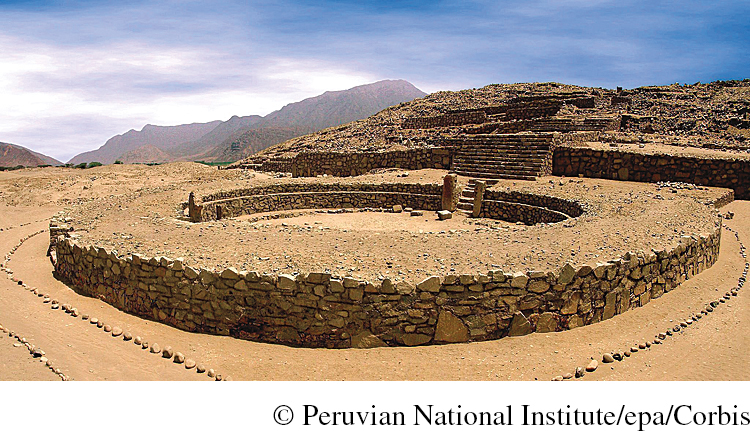ZOOMING IN: Caral, a City of Norte Chico
In early 2001, published reports of archeological excavations at a site called Caral set off a firestorm of amazed commentary in both academic circles and the popular media. And no wonder! Archeologists had uncovered, about fourteen miles inland from the coast of Peru, an urban center dating to the time of the Egyptian pyramids, around 2600 B.C.E., far earlier than any previously known urban settlements in the Americas. Thus Egyptian and Mesopotamian claims to the status of “First Civilizations” were now joined by those of Peru.

Most obviously impressive about Caral was its elaborate and monumental architecture. One of its six pyramids stood sixty feet tall and occupied an area the size of four football fields. Circular sunken plazas, temples, an amphitheater, stairways, and many residential spaces, including apartment-
Smaller finds at the site convey something about ordinary life in Caral. A clay figure with long hair, a colorful costume, and a decorative necklace suggested a shaman, who served as an intermediary between the gods and humans at Caral. The skeleton of a baby, wrapped in layers of fine cloth, had been carefully buried with a necklace of stone beads. Dozens of beautifully carved flutes and cornets made of condor, pelican, deer, and llama bones revealed an instrumental musical tradition. A quipu, consisting of knotted cords and later widely used by the Incas for accounting purposes, pointed to an element of cultural continuity in the Andes region that spanned over 4,000 years.
Archeologists also discovered remains of plants that enhanced sexual performance, as well as hallucinogenic drugs, long used in the Andes and elsewhere in religious ceremonies. A possible hint about Caral’s religious outlook derives from a drawing etched on a gourd, which shows a sharp-
Nor was Caral an isolated instance of urban living. More than twenty other related sites in the river valleys of the area make up what scholars are now calling the Norte Chico civilization. Caral and other inland cities had close relationships with coastal communities, exchanging their agricultural products such as cotton, beans, squash, and sweet potatoes for sardines and anchovies, whose bones have been found in abundance in Caral. Goods from as far away as present-

But what was missing from Caral has proved equally intriguing. Grain-
Questions: In what ways do recent discoveries at Caral invite reconsideration of Andean civilization and of the history of the earliest civilizations generally? What do you find most surprising about Caral?